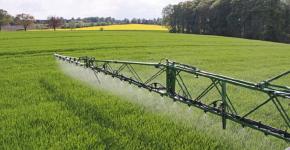Ordinary potatoes. Potatoes in history and mythology. Potatoes - medicinal properties
Photo of flowers of the plant Potato
Potatoes - medicinal properties
Potato It is used as an enveloping, anti-inflammatory agent for gastrointestinal diseases, and as a cosmetic product.
Latin name: Solanum tuberosum.
English name: Potato.
Family: Solanaceae - Solanaceae.
Pharmacy name: starch, potato starch - Solani amylum (formerly: Amylum Solani).
Potato parts used: tubers, flowers.
Botanical description: potato - herbaceous plant up to 50 cm in height. The leaves are imparipinnate; the flowers are white, lilac or violet, collected in semi-umbrellas. From the axils of the embryonic leaves in the underground part of the stem, underground shoots grow - stolons, which, thickening at the tops, give rise to new tubers (modified shoots). At the ends of the stolons, tubers develop, which, in essence, are nothing more than swollen buds, the entire mass of which consists of thin-walled faceted cells filled with starch, and the outer part consists of thin-layer cork tissue. The potato fruit is a multi-seeded, dark green, poisonous berry with a diameter of 2 cm. The tubers ripen in August - September.
Active ingredients: 1 kg of boiled peeled potatoes supplies the body with proteins by 20%, carbohydrates by 40%, vitamins B1 (thiamine) and PP (nicotinic acid) by 60%, vitamin B2 (riboflavin) by 30%, vitamin C by 200%, and potassium (200%), magnesium and phosphorus (50%), iron (60%) and calcium (20%). The calorie content is 800-900 kcal (30% of the daily requirement).
Nutritional value table for 100 grams of jacket potatoes
100 grams of baked potatoes without skin contain 4.29 grams of protein, 46.06 grams of carbohydrates, 7.9 grams, calorie content = 198 kcal.
Vitamins:
- - 10 IU
- - 0.122 mg
- - 0.106 mg
- - 3.065 mg
- - 0.857 mg
- - 0.614 mg
- - 22 mcg
- - 13.5 mg
- - 1.7 mcg
- Other vitamins are absent or contained in the smallest quantities in potatoes.
Macro- and microelements:
- - 7.04 mg
- - 573 mg
- - 34 mg
- - 43 mg
- - 0.616 mg
- - 0.817 mg
- - 21 mg
- - 0.7 mcg
- - 101 mg
- - 0.49 mg
- Other macro-microelements are absent or contained in the smallest quantities in potatoes.
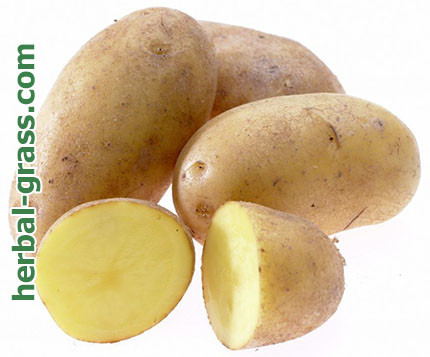
Potatoes - medicinal properties and uses
Potato juice has long been used to treat stomach and duodenal ulcers. And potassium, which potatoes are rich in, is simply necessary for patients with heart and kidney diseases. The starch of this wonderful natural gift is also used for medicinal purposes. Thus, it is used as an enveloping, anti-inflammatory agent for gastrointestinal diseases. Even with severe forms of poisoning, you can eat boiled potatoes.
Recipes
- Infusion of flowers. Pour three tablespoons of flowers into 1.5 cups of boiling water. Leave in a thermos or warm place for three hours.
- Corned beef tincture. Keep the potato tubers in the light for more than 3 weeks, in the sun, until their surface becomes dark green and the inner flesh becomes bright green. Then the tubers need to be washed with water and grated together with the peel (the peel and eyes contain the largest amount of solanine). Squeeze the juice out of the resulting pulp, pour it into a bottle, add vodka in a 2:1 ratio and let it brew for a week.
- Tincture of flowers. 6 days after the potatoes bloom, collect potato flowers (the color does not matter), compact them tightly into a glass jar to the brim. Pour vodka or alcohol over the flowers. At the same time, shake the jar periodically to release the air. Close the jar with a lid and place in a dark place for 20-25 days.
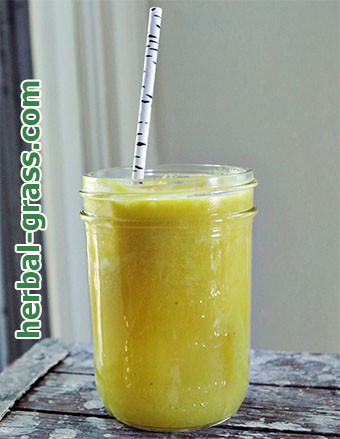
Photo of potato juice
ATTENTION!
Self-medication is dangerous! Before treating at home, consult your doctor.
Treatment with potatoes
- Abscess. Add fresh grated potatoes.
- Acne(acne). For phlegmonous acne, a compress of peeled and grated raw potatoes will help, change every 2 hours.
- Angina. When a sore throat begins, a compress made from raw potatoes is very effective. 2-3 potatoes average size wash, grate together with the peel, place on a double-folded strip of gauze, lightly sprinkle with table vinegar (not essence!). Fold the gauze and wrap this scarf around your throat. Cover the top with plastic and wrap it with a warm scarf or towel. Go to bed. Keep the compress pressed tightly to your neck for 4 hours.
- Angina. Dry the potato flowers in the shade. Pour 1/4 cup boiling water over 1 teaspoon of flowers in a clay pot. The pot can be placed on top of a just boiled kettle and left until it cools. You can either gargle with the decoction or lubricate it with a cotton swab.
- Angina(inhalation). Place washed, unpeeled potato tubers in a saucepan, add water and cook until tender. The steam is inhaled by bending over a pot of potatoes and covering your head with a sheet or blanket.
- Arthritis. For those suffering from gout, arthritis, arthrosis, and heel spurs, the following remedy will help: fill a light glass jar entirely with potato sprouts (choose the thickest and shortest, do not wash), crush lightly. Place the open jar on the windowsill for 2 weeks, after this period, fill the jar with medical alcohol (300 g of alcohol is needed for a half-liter jar), close tightly and place in a dark place for a month. Strain. Rub the sore areas once a day before going to bed. One course of treatment lasts 2-3 weeks depending on how you feel.
- Arthritis. 1 cup of sprouted potato shoots up to 1 cm long, rinse, dry slightly, pour in 0.5 liters of vodka, leave for 21 days, rub sore joints with the tincture.
- Arthritis of the hands. Take a raw, washed but unpeeled potato and hold it in your fist. Put a mitten on your hand (so as not to drop it in your sleep), and sleep like that. It is not necessary to change the potato every time; you can use it until it sprouts or shrinks.
- Myopia. Dry the potato flowers in the shade. Pour clean, cold into a teaspoon boiled water. Drown one dried flower in it. Hold the spoon over the candle until bubbles appear in the spoon (do not bring to a boil!). Cool to the temperature of fresh milk and use a pipette to drop two drops into each eye (no more!). There will be pain and tears in your eyes, but you have to be patient. You need to wipe your eyes with a clean handkerchief. The course of treatment is from 2 weeks to 1-2 months. Do this procedure better in the morning. After 2-3 weeks, check your vision with a doctor. This method cleanses the eyes and restores vision from -3-5 to normal. During treatment you should not wear glasses or use a computer.
- Bowel diseases. Drink 200 ml potato juice every morning 30 minutes before meals. The course of treatment is 10 days, repeat after 10 days.
- Warts. Keep your hands in a decoction of potato peelings. Then dry without wiping. Do the wart removal procedure at night.
- Warts. Apply potato juice to the warts. On half of the potato, make two scratches on the cut, crosswise, make the same scratch on the wart, drip the juice. The warts will disappear in 1-1.5 months.
- Warts. At night and throughout the day, make a compress with tincture of potato flowers. Place the flowers tightly in a medicine bottle, fill to the top with 70% medical alcohol, leave for 10 days.
- Liver pain. Potato applications will help with severe pain in the liver. Mash 0.5 kg of boiled potatoes in their jackets along with the skins and place on linen or linen cloth. Apply a hot potato cake to the sore spot (you should feel a pleasant warmth) and wrap it with a warm scarf on top. Keep the application until it cools, then remove the potatoes and wrap the application area warm again. Such procedures should be done within 3-4 days.
- Joint pain. Wash 3 potatoes, dry and grate on a coarse grater. Wrap the resulting pulp in 3 layers of gauze and apply to the sore joint. Cover the top with plastic and wrap it with a warm scarf. At the same time, take warm potato broth three times a day, 1 glass.
- Bronchial asthma. A 15-minute inhalation over boiled potatoes with the addition of seeds (2-3 tablespoons) or herbs (several sprigs) allows you to get rid of suffocation.
- Inflammation of the gastrointestinal tract. In the morning before meals, drink 1 glass of potato juice, then go to bed for 30 minutes, and after 1 hour you can have breakfast. The course of treatment is 10 days, repeat after 10 days.
- Gastritis. In the morning before breakfast, cut out the eyes from 4-5 potatoes (no need to peel them), then grate them, squeeze out the juice, add 2 teaspoons of honey, stir and drink the entire portion, lie down for half an hour. Then you can get up and eat. Course of treatment: 10 days take juice, 10 days rest, 10 days take juice, 10 days rest, 10 days take juice. Exclude fish, meat, fish and meat products from your diet.
- Chronic gastritis(with normal and increased secretion). Potato juice - half a glass, honey - 1 tablespoon. Mix fresh juice with honey. Drink before meals 3 times a day. The course of treatment is 10 days, after 10 days the course is repeated.
- Chronic gastritis(with normal and increased secretion). Drink 100 ml of fresh potato juice in the morning.
- Hepatitis. For pain in the right hypochondrium, make a poultice from boiled potatoes with peel.
- Hypertension. Three times a day before meals, drink juice from one medium-sized potato. In total, use 3 potatoes per day.
- Hypertension. Drink a decoction of potato peelings three times a day, a third of a glass.
- Hypertension. For hypertension, wash the Sineglazka potatoes thoroughly and boil them in their skins without salt. Drain the broth and drink 1 glass 3 times a day.
- Glossitis(inflammation of tongue tissues). Rinse your mouth 2-3 times a day after eating fresh potato juice.
- Dyspepsia. In the morning on an empty stomach, drink 1 glass of potato juice, then go to bed for 30 minutes, after 1 hour have breakfast. The course of treatment is 10 days.
- Wen(lipoma). Pour 1 tablespoon of dried potato flowers with 0.5 boiling water and leave in a thermos for 3 hours. Strain. Drink 100 ml infusion 3 times a day half an hour before meals. Drink for 10 days, break for 5 days. The course of treatment is 3-4 months.
- Malignant tumors of internal organs. Take half a glass of flower infusion half an hour before meals three times a day. The course of treatment is 14 days.
- Heartburn with high acidity. Drink 100 ml potato juice 3 times a day. The course of treatment is 10-12 days.
- Heartburn. In the morning before breakfast, cut out the eyes from 4-5 potatoes (no need to peel them), then grate them, squeeze out the juice, add 2 teaspoons of honey, stir and drink the entire portion, lie down for half an hour. Then you can get up and eat. Course of treatment: 10 days take juice, 10 days rest, 10 days take juice, 10 days rest, 10 days take juice. Exclude fish, meat, fish and meat products from your diet.
- Heartburn. If you suffer from heartburn, you need to chew and swallow a piece of raw potato.
- Cardiac ischemia. Rinse 1 cup of potato flowers (not subjected to chemical treatment against pests) and pour 0.5 liters of boiling water. Leave for 30 minutes, strain and add 2 tablespoons of honey. Drink 1 tablespoon of infusion 3 times a day before meals.
- Cyst on the kidney. Grind the blue-eyed potato sprouts and put them in a liter bottle, filling it 2/3 full, fill it with vodka and leave for 3 weeks in a dark place. Strain and take 1 time per day, starting with 1 drop in 50 ml of water an hour before meals. Gradually adding the tincture drop by drop, bring the dose to 30 drops per 150 ml of water and begin reducing again to 1 drop. After a week's break, repeat the course of treatment, but increase the dose to 40 drops. The next course is up to 50 drops. If necessary, courses can be continued, increasing the dosage to 100 drops. At the same time, you can drink a decoction of burdock roots (1 tablespoon per 1 glass of water, boil for 5-10 minutes).
- Mastitis. Grate several washed and dried potatoes on a fine grater, squeeze lightly and place the pulp on your chest. Cover the top with a clean cotton cloth, compress paper and a warm scarf. Keep the compress for 2 hours. This treatment procedure should be carried out 2-3 times a day for 2 days.
- Migraine. Potatoes are considered very effective means against migraine. Our ancestors boiled potatoes in their jackets and, for debilitating headaches, not only applied warm potatoes to the forehead, but also drank freshly prepared potato juice, a quarter of a glass, 3 times a day 30 minutes before meals for a week.
- Uterine fibroids
- Uterine fibroids. Every day for six months in the morning on an empty stomach, take 1/2 cup of potato juice, and it is better that the potatoes are pink varieties.
- Calluses. Place potato flowers in a half-liter jar, add vodka, leave for 10 days in a dark place. Make tincture lotions on calluses.
- Frostbite. After restoration of sensitivity, keep the sore spot in warm, unsalted water. potato broth 30 minutes.
- General cleansing of the body. To quickly and harmlessly cleanse the body of fungi and microbes, bacteria, viruses, take 5 drops of solanine tincture in 0.5 glasses of water in the morning and evening 15-20 minutes before meals. After 5 days of taking it, take a break for 5 days. Take 4-5 of these courses at once.
- Burns. Apply potato pulp.
- Oncological diseases. Pour 1 tablespoon of potato flowers into 500 ml of boiling water, leave for 3 hours in a thermos, strain. Drink 1/2 glass 30 minutes before meals once a day. Course of treatment: drink 4 liters of infusion!
- Acute dermatitis(due to sunburn). Apply a compress of peeled and grated raw potatoes, change every 2 hours.
- Puffiness under the eyes. Grate thoroughly washed potatoes on a fine grater. Take two pieces of gauze, put 1 tablespoon of grated potato on each and apply to the eye bags for 10-15 minutes. After this, apply skin cream around the eyes to the areas of swelling in the direction from the bridge of the nose along the lower eyelid to the temples. After 15-20 minutes, use cotton wool soaked in cold tea to remove the remaining cream. The procedure should be done 2 times a day - morning and evening.
- Puffiness under the eyes. Cut boiled potatoes in their jackets in half and apply to closed eyes for 30-40 minutes. The temperature of the potatoes should not be too high to avoid damaging the skin.
- Salt deposits. Pour 2 cups of potato flowers with 0.5 liters of alcohol, bury them in the ground, leave for 10 days, strain. Wipe joints with tincture.
- Cleansing the body. Take 5 drops of solanine tincture per 0.5 glass of water in the morning and evening 15-20 minutes before meals. Drink for 5 days, break for 5 days. Take 4-5 such cleansing courses.
- Swelling of the legs. Grate the peeled potatoes and apply to the sore spot for 20-30 minutes, wrapped in a coarse cloth.
- Otitis. Place 2-3 drops of solanine tincture into the ear and cover with a piece of cotton wool. The pain will go away. Repeat a couple more times for prevention.
- Pancreatitis. Every morning and evening, 2 hours before meals, drink 100-200 ml of freshly prepared potato juice, and 5 minutes later - fresh kefir. It's better to take potatoes Pink colour. Do not remove the peel. Potato juice should sit for no more than 10 minutes! The course of treatment is 15 days, then a break of 12 days. You need to conduct 3-4 courses. Do not eat green tubers, they contain the toxic substance solanine!
- Increased acidity. Take 3/4 glass of freshly prepared potato juice three times a day on an empty stomach, an hour before meals and before bed for 10 days, then take a 10-day break. Repeat the course of treatment. Attention! Juice can be prepared from July to January, as long as the potatoes have low levels of solanine.
- Gout. Fill a light glass jar entirely with potato sprouts (choose the thickest and shortest, do not wash), press lightly. Place the open jar on the windowsill for 2 weeks, after this period, fill the jar with medical alcohol (300 g of alcohol is needed for a half-liter jar), close tightly and place in a dark place for a month. Strain. Rub the sore areas once a day before going to bed. One course of treatment lasts 2-3 weeks depending on how you feel.
- Sweaty feet. Sprinkle your feet with dry potato starch powder.
- Cold. Do inhalations with a decoction of potato peels for 10 minutes.
- Rheumatism. Fill a half-liter glass jar with potato flowers, add alcohol, bury in the ground for 10 days, strain. Lubricate sore areas at night.
- Rheumatism. Dry 10 g of potato sprouts, grind into powder, pour a glass of vodka in a dark glass container, leave for 24 hours. Pour 0.5 cups of olive oil into the tincture and shake. Rub the prepared product onto the sore areas 2-3 times a day, wrapping them in a woolen scarf after the procedure. The procedure is recommended for aching pain.
- Erysipelas of the skin. Place mashed raw potatoes on a cotton cloth and apply to the sore spot.
- Bruises. Bandage slices of chopped potatoes to the site of the injury.
- Boils, pustular skin lesions. Apply a compress of peeled and grated raw potatoes, change every 2 hours.
- Uterine fibroids. Pour 1 teaspoon of dried potato flowers into a thermos with one glass of boiling water. Close the thermos after 5-10 minutes and leave for 4-5 hours. Drink the infusion 3-4 times a day 30 minutes before meals, 1/4 or 1/2 cup. The course of treatment is 1 month. Repeated course - after 1-2 months.
- Uterine fibroids. Take 1/2 cup of juice obtained from raw potato tubers every day on an empty stomach. (if the patient does not have subcutaneous nodes and low acidity gastric juice). Treatment is carried out from June to January: drink juice for 1 month, then take a break for 7-10 days. It is necessary to conduct 3 such courses.
- Uterine fibroids. Rinse 1 cup of potato flowers (not subjected to chemical treatment against pests) and pour 0.5 liters of boiling water. Leave for 30 minutes, strain and add 2 tablespoons of honey. Drink 1 tablespoon 3 times a day before meals.
- Furuncle. Place the raw potato pulp on a clean napkin and apply to the sore spot and secure. Keep the bandage on for 2 hours.
- Spurs on the heels. Grate the potatoes along with the peel, place on gauze, cover with wax paper and bandage to the sore spot. Do not remove such a compress for 24 hours! If necessary, repeat every other day.
- Eczema. For acute dermatitis due to sunburn and for pustular inflammation of the skin, use a compress of peeled and grated raw potatoes, change every 2 hours.
- Duodenal ulcer. Take 1/2-1/3 glass of freshly prepared potato juice before meals in the morning and at lunch.
- Stomach ulcer. For a week, drink a mixture of half a glass of boiled water every morning on an empty stomach, 30-40 minutes before breakfast. warm water and half a glass of freshly squeezed pink potato juice.
- Stomach and duodenal ulcers. Dissolve 1 tablespoon of honey in fresh potato juice. Drink half a glass 3 times a day. The course of treatment is 12-14 days, repeat after 10 days.
Potatoes - traditional medicine recipes:
- Analgesic effect has a compress of grated raw potatoes with honey for osteochondrosis. This compress is kept on the sore spot for at least an hour.
- For hypertension Eat baked potatoes in their jackets more often.
- For swelling of the hands or but d you should peel the potatoes, grate them, apply the resulting potato pulp to the swollen areas and hold for 15-20 minutes, tightly wrapping the “compress” with a cotton or terry towel.
- Potato face mask recipe: prepare “Potato tenderness”, for which you will need a couple of boiled tubers. Mash and mix them (hot) with one yolk, 1 tsp. honey, a small amount vegetable oil(better than olive). Apply the resulting mixture to your face and then rinse off. boiled water. After this moisturizing and softening potato mask, lubricate your face with nourishing cream. Lovers of natural cosmetics, I think, will probably find this recipe useful: mix medium-sized boiled potatoes with 1 tbsp. l. fresh cottage cheese and add 0.5 tsp. honey and half a raw egg. Then apply the prepared paste to the skin of your face and neck. Cover the top with a gauze cloth and hold the mask for 20 minutes, then rinse with warm water. It is useful to make such masks 1-2 times a week for 4-6 weeks. After 2 months the course should be repeated.

Sprouted potatoes are harmful to health
Contraindications. Potato tubers, only dug out of the soil, do not contain the poisonous alkaloid solanine. But if the storage technology is violated, when light hits the tubers, a poison is formed in them, which can cause symptoms of severe poisoning. Green potatoes are contraindicated for consumption. People suffering from diabetes and other serious diseases should consult a doctor about the amount and advisability of consuming potatoes.
Potato - Solanum tuberosum L.
4028mdk09" style="border-style:solid;border-width:6px;border-color:#ffcc66;" width="250" height="333">
style="border-style:solid;border-width:6px;border-color:#ffcc66;" width="300" height="202">
style="border-style:solid;border-width:6px;border-color:#ffcc66;" width="300" height="225">
Other names: Nightshade tuberous.
Diseases and effects: peptic ulcer, gastritis, arthritis, belching, heartburn, nausea, constipation, burns, eczema, polyarthritis, freckles, skin cracks, cardiovascular diseases, acute respiratory diseases, dry skin, sunburn, colds, diabetes.
Active substances: starch, protein, sugar fructose, sucrose, fiber, fats, lemon acid, malic acid, oxalic acid, vitamins B 1, B 2, B 3, B 6, D, PP, K, E, H, U, ascorbic acid, folic acid, carotenoids, essential amino acids, calcium, potassium, phosphorus, iron , magnesium.
Time to collect and prepare the plant: September October.
Botanical description of potatoes
Potato- perennial herbaceous, tuberous plant of the family Solanaceae.
Root rod-like, fibrous, highly developed.
A characteristic feature of potatoes is the formation of underground shoots - stolons, on which the tubers develop (the scientific name of the plant precisely reflects this feature - tuberous nightshade). Tubers serve as a container for spare nutrients and organ vegetative propagation. On their surface there are noticeable depressions (“eyes”), each of which contains 3 buds with the rudiments of leaves and roots. Only the middle bud begins to grow. Aboveground shoots and roots grow from it. Potato tubers are round, round-oval, elongated-oval, long, flat and others. The main color types are white, yellow, pink, red, purple.
Stems potatoes are erect, juicy, ribbed, branched, fluffy, due to hairs pressed to the stem. The height of the stems is 30–150 cm. At the junction of the edges on the edges of the stems, outgrowths of green tissue, the so-called wings, sometimes form. Each plant usually has 4–8 stems. Plants developing from large tubers on fertile, sufficiently moist soils have more stems.
Leaves intermittently unpaired pinnately dissected, with 7-11 large and smaller leaves, ovoid, pointed, with an unequal base, glabrous above, downy below. Potato leaves are arranged on the stems in a spiral. Where they emerge from the stem, the leaves have stipules. Simple, entire leaves appear first, but they soon die off. The main leaves are imparipinnate with short petioles.
Flowers five-membered ones are collected at the top into inflorescences-curls. They have a green calyx (consists of 5 sepals) and a clepalatal corolla (white, pink, blue, purple), against which orange or yellow stamens fused with anthers stand out. The pistil consists of a stigma, a style and an ovary. After fertilization, the ovary grows and turns into a fruit.
Fetus- a spherical green berry (which later becomes dark purple) 1.5-2 cm in diameter. The seeds of the fruit (small, yellow) very often turn out to be sterile. When ripe, the berries first turn white and acquire a pleasant smell. The fruits are poisonous.
The plant blooms in June - July.
Distribution and habitat of potatoes
The homeland of the potato is South America, where it was introduced into culture in ancient times.
Potatoes are now grown everywhere in all countries. former USSR, planting as a field crop.
Potato harvesting
Potatoes are grown as an annual crop. Tubers of red varieties are collected in the fall.
Typically, potatoes are propagated by tubers, less often by true seeds, as well as parts of a tuber with 1-2 eyes, tops, light and etiolated sprouts, layering and cuttings. When sowing seeds, the main root develops from the rudimentary root and is, as it were, a continuation of the stem. The roots can penetrate to a depth of 1 m. However, the bulk of them are located in the arable layer of soil.
The optimal soil temperature for seed germination is about 20 °C, for tubers - 7-8 °C. Potato tubers are germinated before planting at a temperature of 12-15 °C. The higher the temperature at the same soil moisture, the faster the germination of tubers. Shoots at a temperature of 11-12 °C appear on the 23rd day after planting, at a temperature of 14-15 °C - on the 17-18th day, at 18-20 °C - on the 12-13th day, and at 27-28 °C - on the 6-7th day.
If in the spring after planting for a short time the soil temperature is within 1-5 ° C, then the tubers do not develop sprouts, but immediately small tubers. This phenomenon is observed especially often in cases where the seed tubers were previously stored warm. The most favorable air and topsoil temperature for tuber formation is 17-18 °C during the day, and 12-14 °C at night. When the temperature rises to 29-30 °C or decreases to 2 °C, tuber growth stops. Tubers freeze at −1.7-2 °C.
How more fertile soil and the more it is water holding capacity, the less water is needed to obtain good harvest. Like all living things, potatoes breathe, using starch and sugar for respiration. In tubers, respiration occurs through small holes in the skin called lentils. Excess water in the soil prevents air from entering it, which adversely affects the growth of young tubers. In such tubers, the lentils grow strongly in the form of fluffy warts white on the surface of the peel. This phenomenon occurs when there is excessive watering or in the event of a large amount of rain; In these cases, the tubers often rot.
Potatoes are a very light-loving plant. With a lack of light, it stops blooming, produces few tubers of poor quality, and if there is a lot of shading, it dies. In areas that are well fertilized, but with very thick planting, plants suffer from a lack of light, resulting in a decrease in yield.
For its growth and development, potatoes use many chemical substances- nitrogen, phosphorus, potassium, calcium, magnesium, sulfur, boron, iron, copper and others entering it through root system from the soil. The need for nutrients increases as the tops grow and reaches a maximum during the flowering phase. Potatoes consume especially a lot of potassium and phosphorus in July - during the formation of tubers. Most often, potatoes need additional nitrogen added to the soil, especially in humid climates and on light soils, or potassium on peat soils and where little is added. organic fertilizers- manure. However, the surplus in nitrogen fertilizer promotes accelerated growth of stems with weak development of the root system. As a result, plants with excessively lush tops evaporate a lot of moisture and often suffer from a lack of it. If there is a lack of nutrients in the soil, signs appear on potato leaves indicating a deficiency of one or another element: with a lack of potassium, the leaves become wrinkled, their edges bend down, acquire a bronze-brown-green color and die prematurely. With a lack of nitrogen and phosphorus, the leaves are lighter in color than those of normal plants and stick up. With a lack of magnesium in the leaves, brown spots appear between the veins (along the midrib of the leaf lobes).
By adding organic fertilizers to the soil, as well as mulching the soil with humus, peat, and compost, you can almost double the amount of carbon dioxide released from the soil. And the more carbon dioxide in the air, the more it is absorbed and used by the plant to produce starch.
Potatoes develop best on loose, light-textured soils with a fine-lumpy structure. For its cultivation, sandy loam, light loam and lowland cultivated peatlands are preferable. It does not grow well in areas with high level groundwater. Potatoes tolerate increased soil acidity better than other plants, but slightly acidic soils are most suitable for it.
In the gardens and personal plots Potatoes are often forced to be grown continuously for decades. Continuous cultivation of potatoes in one place contributes to the accumulation of diseases and pests, as well as some types of weeds.
Flowers, potato shoots, potato peels and underground tubers, which are harvested during their ripening period, are used for medicinal purposes. One thing to remember about potato tubers is that they must be stored in a dark place. Otherwise (if the tubers lie in the light, especially in the sun), they take on a green color and become poisonous, unsuitable for food, let alone medicinal use.
It is known that freshly harvested tubers do not germinate even if they are placed in favorable conditions for this purpose. This is explained by the fact that after harvesting the tubers are in a state (period) of natural dormancy.
Chemical composition of potatoes
Potato tubers, depending on the variety and growing conditions, contain 14-22% starch, 1-2% protein (in potatoes it is called tuberin), 0.5-1% sugars (sugar fructose and sucrose) and about 1% mineral salts, and also contains fiber, fats, organic acids (mainly citric, malic and oxalic) and other compounds.
Vitamins B 1, B 2 (riboflavin), B 3, B 6, ascorbic (up to 50 mg%) and folic acids, carotenoids, vitamins D, PP, K, E, H, U, essential amino acids, salts were found in potato tubers calcium (8 mg%), potassium (426 mg%), phosphorus (38 mg%), iron (0.9 mg%), magnesium (17 mg%) and other substances important for human health. In total, tubers contain 32 microelements. Potato proteins contain 14 amino acids out of 20 necessary for the construction of cells in the human body, including all 8 that are essential, i.e. they are not synthesized in the human or animal body and must be obtained from food.
Nitrogenous substances are concentrated in the core of the tuber and under its skin, that is, where there is less starch.
The biological value of potato proteins is one of the highest among plants (85% of the value of proteins chicken egg and 100% digestibility in humans and animals).
Potatoes are the main supplier of potassium to the body. There is no such amount of potassium in bread, meat, or fish. An adult's potassium requirement is about 2 g per day, which can be met by eating 400 g of potatoes per day. Sufficient provision of the body with potassium is especially important for people with diseases of the cardiovascular system, atherosclerosis, as well as for the elderly.
Pharmacological properties of potatoes
In medical practice, potato tubers are used not only as a source of vitamins, but also for the prevention and treatment of a number of diseases. The tubers of the plant have anti-inflammatory, wound-healing, antispasmodic and diuretic properties. Starch obtained from potatoes has a softening, enveloping and anti-inflammatory effect.
Potato juice inhibits the secretion of the digestive glands. Due to the presence of acetylcholine in potato tubers, constant use of potato juice helps reduce blood pressure.
Use of potatoes in medicine
Potato tubers occupy a leading place in dietary nutrition. They are included in the diet of patients suffering from cardiovascular diseases, metabolic and gastrointestinal diseases. Fresh juice is effective for gastritis and peptic ulcers, accompanied by increased secretion of gastric juice. Potato juice (1/2 cup), taken 30-40 minutes before meals, improves digestion and normalizes intestinal function.
The use of potatoes for diseases of the cardiovascular system is due not only to the high content of potassium salts in it, but also to the diuretic and antispasmodic properties of the plant. A positive therapeutic effect of grated fresh tubers has been noted when used externally for the treatment of burns, eczema-like and other skin diseases. Acute and chronic respiratory diseases are treated by inhaling vapors containing a number of volatile medicinal substances when grinding freshly boiled potatoes.
For cosmetic purposes, face masks are used, made from potatoes boiled in their jackets, mixed with cream or sour cream. Such masks are especially effective for dry skin and the treatment of sunburn.
IN folk medicine fresh potato juice is prescribed orally for high blood pressure; it also helps reduce the secretion of acid by the digestive glands and scarring of ulcers on the mucous membrane of the digestive tract.
Potato starch is used as a base for powders and fillers in powders and tablets.
For colds of the upper respiratory tract, potato steam is inhaled (the therapeutic effectiveness of this procedure is questionable, but the relief of the condition is undeniable).
Potatoes that have turned green in the light, containing solanine, are used for compresses for arthritis.
Eating potatoes helps remove toxins from the body and thereby helps regulate metabolic processes. Potassium, contained in large quantities in potatoes, plays a positive role in maintaining the normal function of the heart muscle and, according to the latest scientific data, can be classified as an anti-sclerotic agent. Thanks to potassium, potatoes have a diuretic effect. Therefore, it is included in the diet of patients suffering from diseases of the cardiovascular system and kidneys.
Potato juice lowers blood sugar levels, so it is useful in the early stages of diabetes.
Dosage forms, method of using potatoes
Potato tuber juice. Well washed and wiped dry, the tubers along with the skin are grated or ground in a meat grinder. The juice and starch are squeezed out through 2 layers of gauze. Raw juice is taken 1/2-1/3 cup (about 100 ml) 3 times a day before meals, then before lunch and before dinner for 2-3 weeks. After a week's break, the course is repeated.
In total, a course of treatment requires from 5 to 15 liters of raw juice. At the same time, they adhere to a gentle diet: drug treatment and physiotherapeutic procedures are suspended for this time.
To prevent exacerbations of the disease, patients with peptic ulcers are recommended to take raw potato juice for two weeks in the fall and spring (from half of September to half of October and from half of March to half of April). At the same time, pain, belching, heartburn, nausea disappear, the acidity of gastric juice normalizes, patients gain weight, constipation and bloating disappear. Treatment with raw potato juice does not produce side effects.
Juice with milk or sour cream is also used to get rid of freckles and cracks from open parts of the skin.
Chopped raw potato tubers. They are considered a good healing agent for burns, eczema and other various skin lesions. The ground mass is simply applied to the affected areas of the skin.
Peel a medium-sized potato, cut it into small pieces and chew slowly one by one for heartburn.
Boiled potatoes. Potatoes are an effective means of cleansing joints of toxins and are considered good remedy for polyarthritis. To do this, within 3 days you need to eat 2-3 kg of potatoes, boiled with peels in a large amount of water. Potatoes are mashed in broth and eaten with the peel. Do not take other food at this time. To eat potatoes with skins, you need to cook them for a long time.
Contraindications to the use of potatoes
We should not forget about the possibility of severe poisoning when eating low-quality potatoes. Poisoning occurs due to the content of a highly active glucoalkaloid, solanine, in sprouted tubers, especially in the peel and so-called eyes. In small doses, this alkaloid has a cortisone-like anti-inflammatory effect, and in large doses it can have a toxic effect. During long-term storage and strong germination of potato tubers or their greening and rotting, the solanine content can increase sharply, which leads to various forms poisoning In large doses, solanine inhibits the function of the central nervous system and damages the formed elements of the blood.
Poisoning by poor-quality potatoes is characterized by nausea, vomiting, dyspeptic symptoms, shortness of breath, palpitations, convulsions, and in severe cases, short-term loss of consciousness. With timely medical care, the symptoms of poisoning are relieved.
The use of potatoes in nutrition
In our countries, potato tubers are one of the most common food products. Due to its nutritional value and high content of vitamins, amino acids and minerals, potatoes should be given one of the leading places in terms of dietary, therapeutic and prophylactic value. Almost half of the daily requirement for ascorbic acid can be met by eating potatoes, and 200 g of fresh potatoes contain almost the full daily dose of ascorbic acid.
When cooking, potatoes should not be exposed to high temperatures for a long time due to the possible destruction of vitamins.
Because potatoes are alkaline, they make an excellent addition to all vegetables, milk and cheese.
Other information about potatoes
At the end of the 19th century, the area under potatoes on the planet was about 15 million hectares, after the First World War - already 21 million hectares, and after the second - about 24 million hectares. In recent decades, there has been a reduction in potato plantings: by the end of the 80s of the last century, the total area under potatoes did not exceed 18 million hectares. However, due to the increase in productivity, its gross harvests did not decrease.
Nowadays, a significant part of the potato tuber harvest is used for starch production and alcohol production.
Potatoes in history and mythology
Potatoes began to be cultivated approximately 14 thousand years ago by the Indians of South America. In the burials and burial grounds of the Indians, vases in the shape of interconnected potatoes were discovered, as well as the dried tubers themselves. There are about 200 wild and cultivated potato species, native primarily to South and Central America. There are two main cultivated species: Indian (since ancient times grown in Colombia, Peru, Ecuador, Bolivia) and Chilean (homeland - Central Chile), which are widespread in countries with a temperate climate.
Potatoes were brought to Europe by conquistadors. In 1553, the book “Chronicle of Peru” was published in the Spanish city of Seville. Its author, who visited this country, wrote: “Papas is a special type of groundnut. Once cooked, they become soft, like a baked chestnut... They are covered with a peel no thicker than the skin of a truffle.” This was the first written mention of potatoes in Europe. Potatoes were originally called truffles. At first, this plant was grown only in botanical gardens and pharmaceutical gardens. As a delicacy, it was sometimes served on the table of kings and nobility.
From Spain, potatoes go to Italy, then to Belgium and other European countries. Initially, this plant was considered everywhere in to a greater extent like a curiosity with beautiful flowers and to a lesser extent as a source of food. Therefore, many high society fashionistas pinned bouquets of potato flowers to their hair.
Ordinary people also reacted differently to potatoes. The potato varieties cultivated at that time were too bitter (due to the excessive solanine content) and therefore not everyone liked them. In addition, there were many superstitions around potatoes at that time. It was rumored that the fruits of this plant would be born with a head and eyes like a person’s, so eating potatoes means eating human souls. There were also those who called the potato a “devil’s apple” that seduced the biblical ancestors of mankind - Adam and Eve - with its fruit. And, therefore, a person who eats potatoes was clearly recognized as a sinner. The bad reputation held such a strong hold among the people that they flatly refused to plant potatoes. This happened in all European countries without exception. The rulers of some countries tried to force people to grow potatoes, while others tried to use cunning and bribery. For example, in Prussia, at first, peasants were forced to plant potatoes under the escort of dragoons, and in England they promised to give out gold medals for growing potatoes, etc.
In France they resorted to a trick. Potatoes were planted in fields owned by the state. As soon as it began to bloom, an armed guard was assigned to each bush, which was deliberately removed at night. This aroused some interest among the surrounding peasants. “Apparently these “damn apples” are of great value to the state,” the amazed people reasoned. And we decided to plant potatoes too. And the peasants began to secretly dig up tubers and plant them in their fields. Naturally, no one punished them for this. Having tasted the grown tubers, they were able to make sure that the potatoes were tasty, gave a large harvest and they could make good money from them. This is how potatoes “conquered” France. But it was only in the 18th century that potatoes received wide use in the fields of peasants in all European countries, and even later in Asia, Africa, Australia and North America.
Potatoes came to Russia thanks to Peter I, who sent a bag of tubers from Holland in 1698. And after the Senate decree of January 19, 1765, potatoes began to be purposefully bred. However, as a result of violent tsarist measures to introduce potato crops in 1834-1844, there were unrest among peasants in the Vyatka and Vladimir provinces, the Urals, Lower and Middle Volga regions. The Old Believers turned out to be his especially fierce opponents. They composed a teaching that it is a sin for a Christian to eat potatoes. In the book “Life of the Russian People,” published in 1848, it is written: “There are districts where peasants are even afraid to plant it, thinking of bringing God’s displeasure on their fields.”
Since the potato spread in Europe, scurvy epidemics have ceased: potatoes satisfied almost 50% of the body's need for vitamin C.
Potatoes in dreams

Potato, or tuberous nightshade, is a perennial tuberous plant from the flowering division, class Dicotyledons, order Solanaceae, family Solanaceae, genus Nightshade.
The name “potato” (lat. Solanum tuberosum), by which today’s average person knows this plant (vegetable), was proposed by Caspar Baugin in 1596. The Italians, due to the external similarity of the fruiting bodies with potato tubers, began to call them “tartuffolli” or “tartofel”. From this word a German version of the name for underground fruits “Kartoffel” was formed, which gave it its Russian name.
Potatoes - description and appearance. The structure of plants and vegetables.
The number of stems in one plant ranges from 4 to 8-10. Their height, depending on the potato variety, may not exceed 30 cm or reach 1.5 meters. On the erect, fleshy stems of a green (sometimes with a brown tint) color, peculiar ribs are clearly visible. Dark green potato leaves on short petioles rise in a spiral shape from the base to the top.
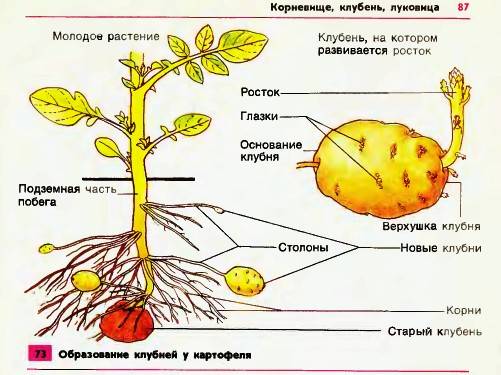

From the part of the potato stem immersed in the ground, shoots (stolons) diverge in different directions, the length of which can reach 0.5 m. At their ends there are potato tubers, the thin outer shell of which is formed by cork tissue. On their surface there are depressions called ocelli. They contain several buds, from which a new plant develops. The flowers of the plant, collected at the top of the stems, are usually white. However, there are varieties with pink, blue or purple flowers. Below you can see what a potato stem looks like, as well as the detailed structure of a potato.
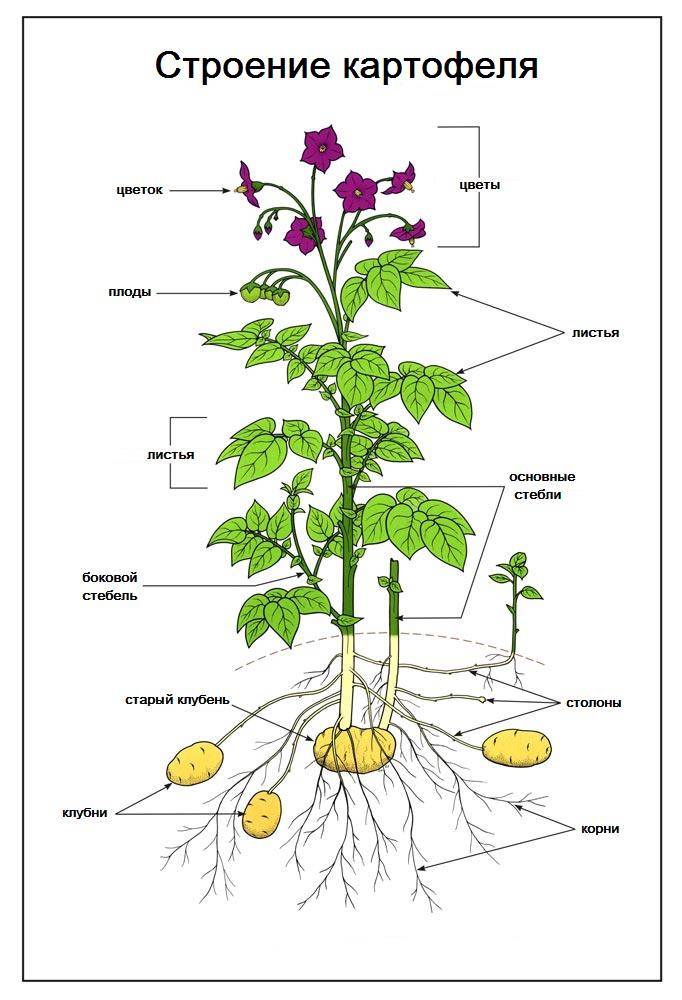
The above-ground potato fruit is a poisonous green berry, shaped like a miniature tomato. As it ripens, it acquires a whitish tint.


The appearance, weight, and color of the top layer of the potato tuber and its pulp differ depending on the variety. The skin of the tuber can be colored in various shades of brown, yellow, pink or purple. Therefore, it is impossible to give a definite answer to the question of what color the potatoes are.
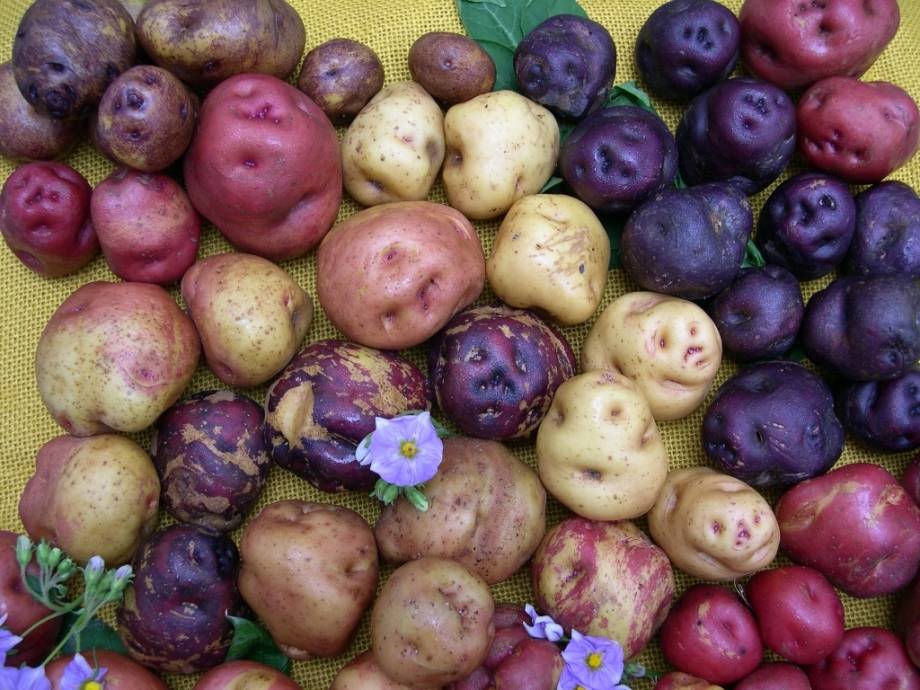
When cut, the potato flesh is usually white, but there are varieties with dark yellow, cream or even purple, blue and pink coloring.


The shape of potato tubers can be round, oblong, spherical or abstract, with protrusions and irregularities, and the weight of individual specimens can reach 1 kg or more.
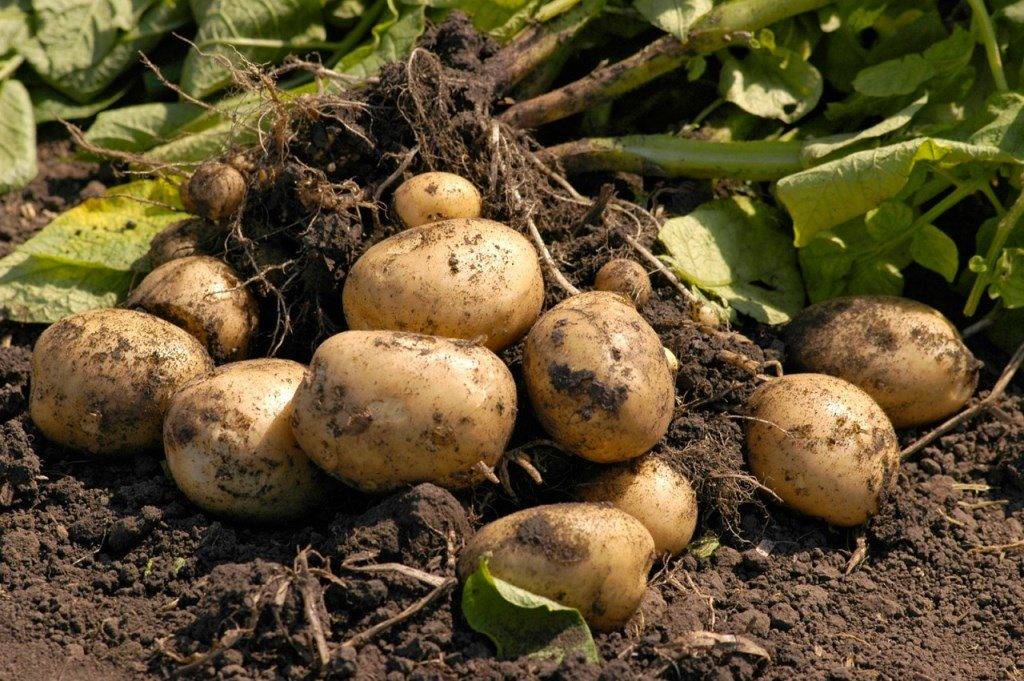
Potato varieties - photos and descriptions.
Today, approximately 5,000 varieties of potatoes are known. Of these, 260 are recommended for breeding on large farms and for private use in Russia.
By practical application All varieties are divided into the following groups:
- “Phelox” is a variety of table potato with elongated tubers weighing up to 110 g. The flesh is light yellow, the skin is darker.
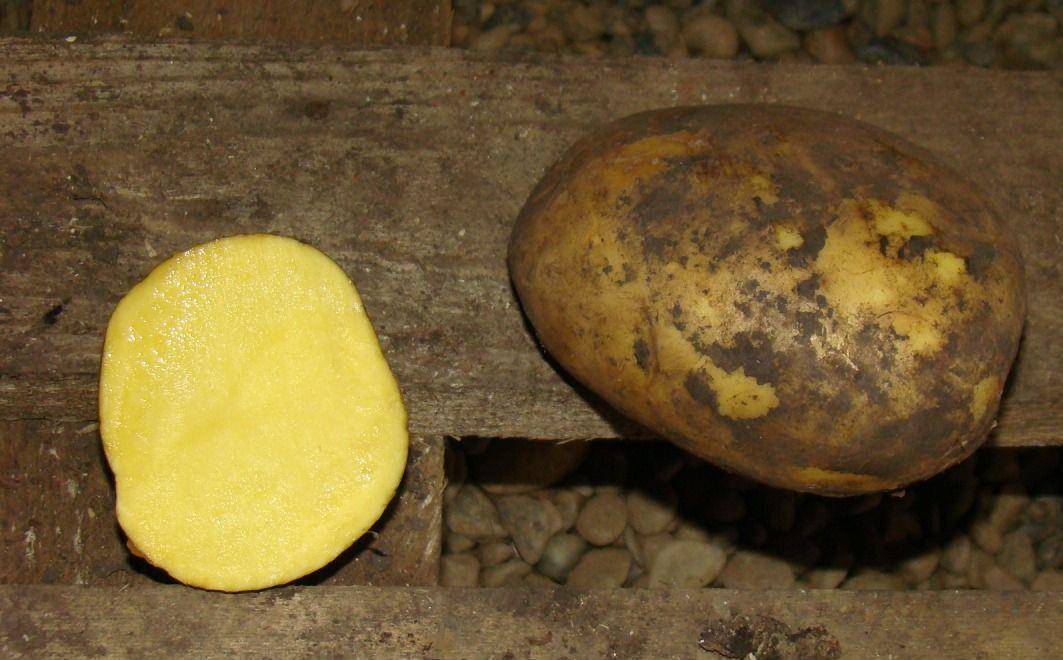
- “Red Scarlett” is a potato variety with oval tubers weighing up to 85 g. One bush contains up to 23 potatoes with smooth red skin and yellow flesh.

- “Nevsky” - potatoes with oval-shaped tubers with pink eyes and weighing up to 130 g. The top layer and flesh are white.
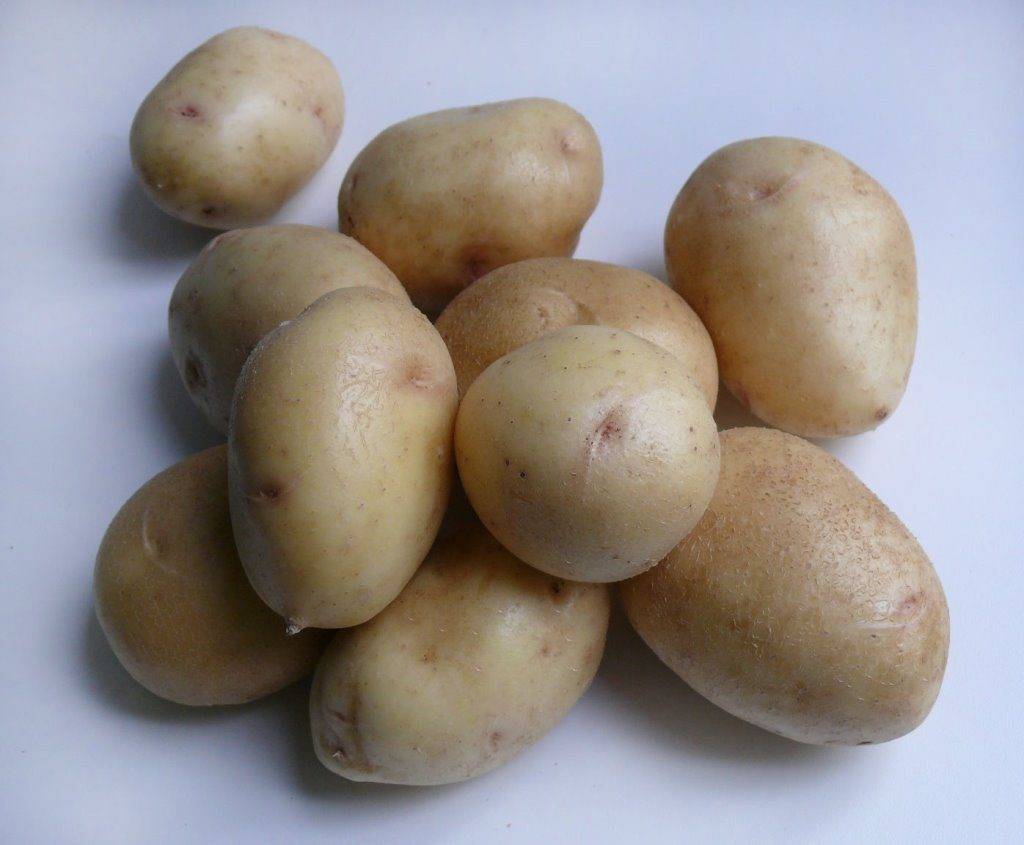
- “Vitalot” is a variety of purple potatoes, has oblong-shaped tubers up to 10 cm long. Highly starchy, boils heavily, and retains its purple-blue color when cooked. It ripens late and has low yields, so it is not grown on an industrial scale.
 Technical varieties of potatoes– used as raw materials in the industrial production of alcohol and starch. The starch content in tubers exceeds 18%. The most commonly grown varieties are:
Technical varieties of potatoes– used as raw materials in the industrial production of alcohol and starch. The starch content in tubers exceeds 18%. The most commonly grown varieties are:
- “Accent” - with large potatoes that have a smooth yellow surface and light creamy flesh.

- “Mountaineer” – medium-sized potatoes. The yellow peel is covered with a fine mesh with numerous small eyes. The tuber is cream-colored when cut.

- “Outflow” - under one bush there can be up to 10 potatoes weighing about 135 g. The surface of the yellow peel is covered with a sparse mesh. The flesh is cream colored.
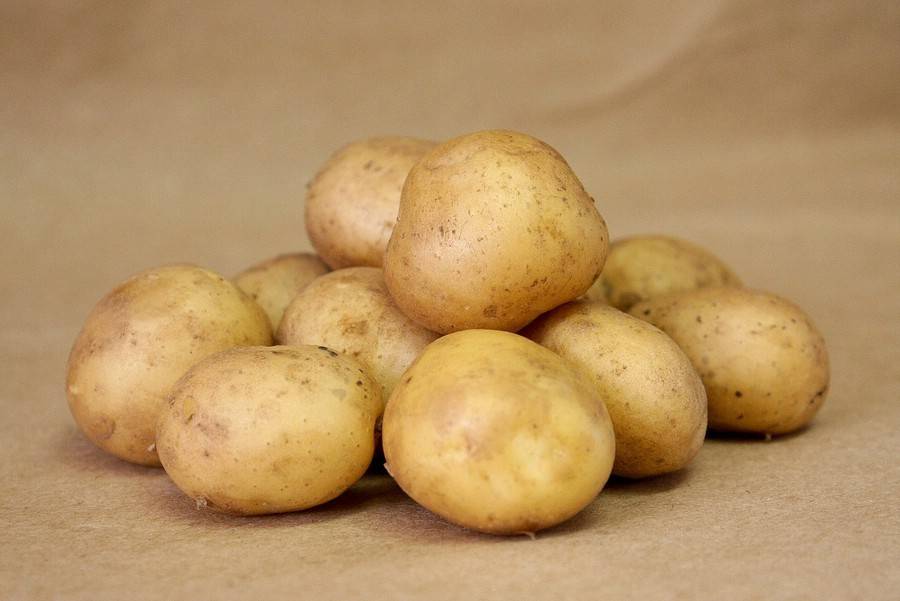
Fodder potato varieties– used as livestock feed. A characteristic feature of fodder potatoes is their high protein content, reaching 3%. Among them are the following varieties:
- "Woltman" is a fodder potato variety with red tubers with numerous light eyes and white flesh. They have an irregular angular shape.
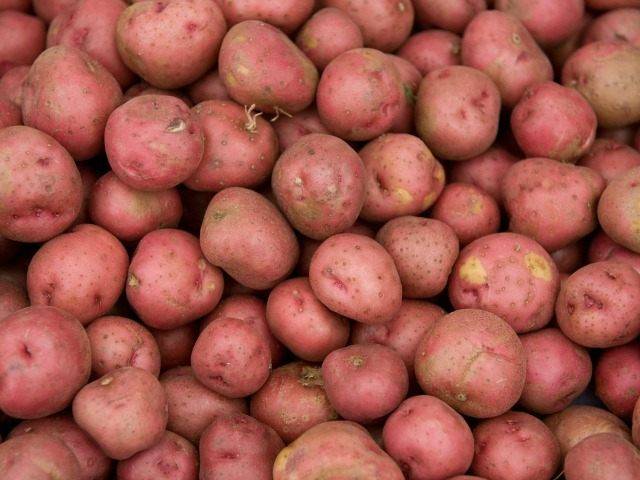
- "Lorch" - oblong tubers covered with smooth skin beige colour, have white pulp with a protein content of up to 2.2% and vitamin C up to 18%. Numerous shallow eyes are located throughout the surface of the tuber.

Universal potato varieties occupy an intermediate position between table varieties and potatoes intended for technical use.
- "Berlichingen" is a potato variety with red, oval-shaped tubers. The peel is strong and thick with superficial eyes. The white flesh darkens when cooked.
![]()
- “Arosa” is a variety with oval reddish tubers and yellow flesh. The stems are spreading with red-violet corollas.
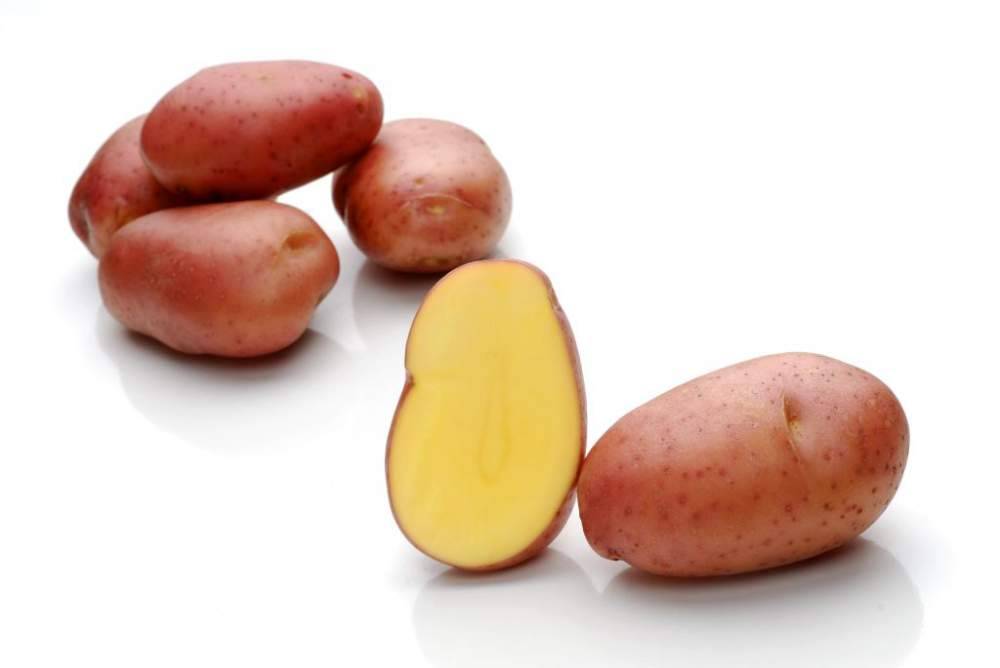
- "Sante" - has oval-shaped tubers with light yellow skin and pulp.
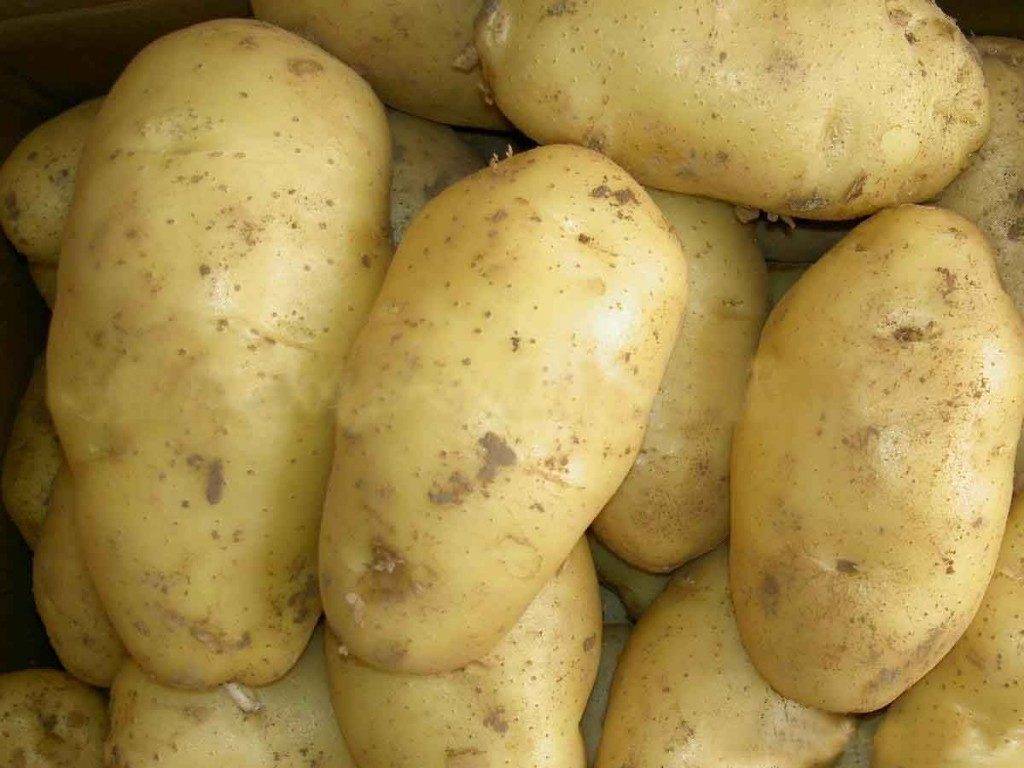
- “Lasunok” - its medium-sized oval-shaped tubers with a mesh skin of light yellow color and creamy pulp.
![]()
Potato ripening period.
There is a classification of potatoes according to their ripening time:
- Early potato varieties. The maturity of early potatoes occurs after 50-60 days, so they are practically not intended for long-term storage. The following varieties are popular:
- Minerva;
- Ariel;
- Felox;
- Red Scarlett et al.
- Mid-early potato varieties. To get a good harvest of mid-early potatoes planting material germinated in advance. The ripening period of this species is up to 80 days. The most popular varieties are:
- Carat;
- Santa;
- Adretta, etc.
- Mid-season potato varieties. The duration of the growing season for mid-season potatoes reaches 100 days. The following varieties are in great demand:
- Nevsky;
- Altair;
- Betina;
- Rosinka et al.
- Mid-late and late varieties potatoes. The ripening period ranges from 100 to 120 days. It is intended for long-term storage. Such planting material can be planted without pre-germination. Good results are obtained by planting such popular varieties as:
- Bernadette;
- Berlinger;
- Folva;
- Accent;
- Slavyanka, etc.



